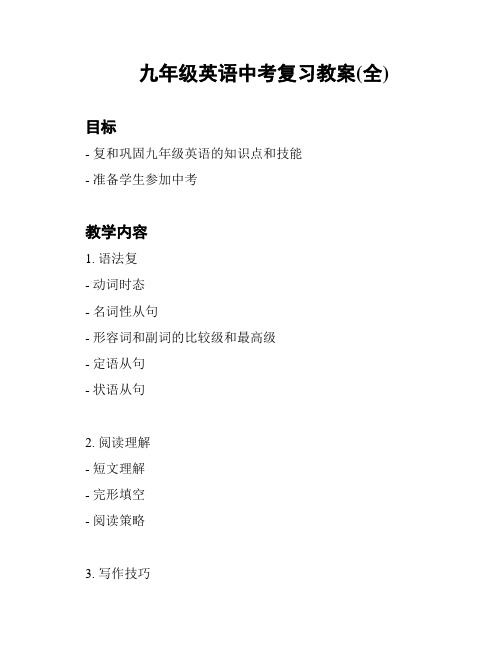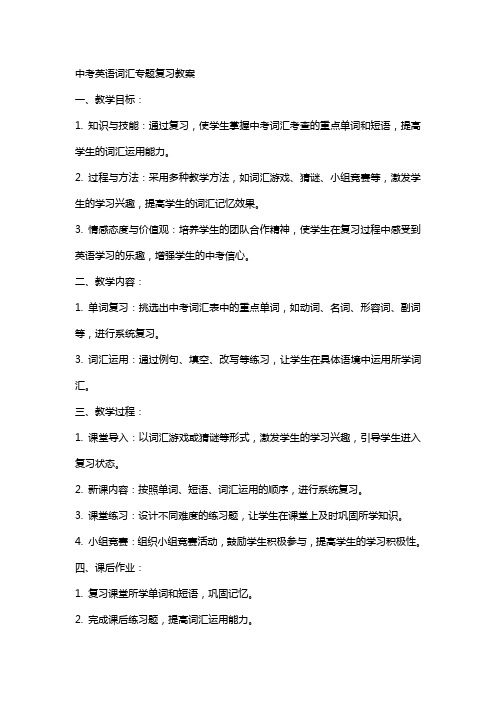中考英语复习教案
九年级英语语法总复习教案(40课时)

中考英语总复习教案一语法重点:一般现在时态(Simple Present tense)难点突破:一般现在时态中第三人称时动词加“s”的用法知识目标:通过操练、点评、专项练习等方式复习“一般现在时态”的时态结构。
复习步骤设计:(一)词汇复习Revision of the words and phrases, dictation of the main ones。
(此环节也可根据中考词汇表顺序进行听写检查)(二)对话操练Dialogue Acting—ask Ss to act out some dialogues about What do you usually do on Sundays/in the evening? (此环节也可以采取学生达标积分制进行,即复习阶段课前对话必须人人参与)(三)语法复习:一般现在时态:(A) 概念:表示某人/某事物经常发生的动作、习惯、状态等。
(B) 时态信号:常与sometimes, often, usually, always, every day, in the morning, on Sunday 等词连用。
(C) 动词形式:用实义动词原形,第三人称时用动词加“s”形式,简称“三单动s”形式,“Be”动词用“am/ is/ are ”的形式。
(D) 情态动词后面直接加实义动词原形。
(E) 在某些动词后面须用动词原形进行搭配,如let sb do sth, You’d beterr do sth 等。
例解:1、Now let me ____ your names, OK?A. callB. to callC. callingD. calls此题应选用“A”项。
在“Let sb.”后面的结构中应该用动词原形结构,不可以用其它形式,所以B项、C项和D项都是错误的。
2、He ________ the washing on Sundays. He _____ it on Saturdays.A. doesn’t/ doesB. don’t do/ doesC. doesn’t do/doesD. not does/ does此题应选用“C”项。
九年级英语中考复习教案(全)

九年级英语中考复习教案(全)
目标
- 复和巩固九年级英语的知识点和技能
- 准备学生参加中考
教学内容
1. 语法复
- 动词时态
- 名词性从句
- 形容词和副词的比较级和最高级
- 定语从句
- 状语从句
2. 阅读理解
- 短文理解
- 完形填空
- 阅读策略
3. 写作技巧
- 书信写作
- 日记写作
- 描写人物和地方
- 表达观点
4. 听力训练
- 听力对话
- 听力短文
教学方法
- 教师讲授和解析
- 学生互动和合作
- 练和应用
教学步骤
1. 复上一节课的知识点和练题
2. 讲解新的知识点和相关规则
3. 给学生提供相关的题和例句
4. 学生个别练和小组合作
5. 批改和讲解练题的答案
6. 答疑和巩固复内容
教学评价
- 练题的成绩和进步情况
- 学生参与度和表现
- 学生的口头和书面表达能力
- 学生对知识的理解和应用能力
- 学生对复内容的掌握程度
教学资源
- 九年级英语教材
- 复参考书籍和题集
- 录音设备和听力材料
教学时间
- 每次课程持续时间:60分钟
- 教学总时间:根据计划安排,一般为10~20次课程
注意事项
- 教学过程中要鼓励学生积极参与和提问
- 注重学生的听力和口语训练
- 确保学生掌握重点和难点知识
- 及时反馈学生的研究情况和进展
以上为《九年级英语中考复习教案(全)》的大致内容和教学计划。
根据具体情况,可以适当调整教学内容和时间安排,确保学生能够全面复习并准备好中考。
初三英语中考教案七篇

初三英语中考教案七篇初三英语中考教案七篇初三英语中考教案都有哪些?随着中国经济社会的进展,英语教学开头提倡培育复合型人才。
培育模式有“英语+专业(如英语+新闻、英语+经济)”“复语(如英法双语、英德双语)”和“主辅修”。
下面是我为大家带来的初三英语中考教案七篇,盼望大家能够喜爱!初三英语中考教案(篇3)初三英语中考教案(篇4)一、教学目标:1.语言学问目标:1)能把握以下单词:growup,computerprogrammer,cook,doctor,engineer,violinist,driver,pilot,pianist,scientist,besurea bout,makesure能把握以下句型:①─Whatdoyouwanttobewhenyougrowup?─Iwanttobeabasketballplayer.②─Howareyougoingtodothat?─I’mgoingtopracticebasketballeveryday.③Whereareyougoingtowork?④Whenareyougoingtostart?⑤I’mnotsureaboutthat.2)能了解以下语法:把握一般将来时态的构成形式;3)用一般将来时态表达将要做的事情。
2.情感态度价值观目标:每个人都有自己的幻想和对将来的准备,对于将来想要从事的职业也布满了向往。
人们以常谈论他们的设想,因此,应通过学习这单元的内容来激发同学们的学习主动性和学习爱好,使他们更加有抱负,并为实现自己的抱负而不断努力。
二、教学重难点1.教学重点:1)学习一般将来时态的构成方式。
2)学习本课时消失的重点句型,通过在不怜悯景下运用来娴熟运用一般将来时态。
2.教学难点:用一般将来时态表达自己将来的准备。
三、教学过程Ⅰ.Lead-in1.介绍自己小时候想要从事的职业,由此归纳出以前所学过的一些职业的英语表达方式:teacher,nurse,doctor,basketballplayer,runner,actor,actress…2.询问同学们想要从事的职业,从而引出句型:─Whatdoyouwanttobewhenyougrowup?─Iwanttobeabasketballplayer.3.同学们看幻灯片,引导同学们进行问答自己将来所喜爱的职业。
2024年中考英语复习教案宾语从句

2024年中考英语复习教案宾语从句一、教学目标:1. 让学生掌握宾语从句的定义和基本结构。
2. 培养学生正确运用宾语从句进行交际的能力。
3. 提高学生对中考英语宾语从句题型的应试能力。
二、教学内容:1. 宾语从句的定义和分类。
2. 宾语从句的基本结构及连接词。
3. 宾语从句的时态和语态。
4. 宾语从句的常见句型和用法。
5. 中考英语宾语从句题型解析。
三、教学重点与难点:1. 宾语从句的基本结构及连接词。
2. 宾语从句的时态和语态的运用。
3. 宾语从句在实际语境中的运用。
四、教学方法:1. 采用任务型教学法,让学生在实际操作中掌握宾语从句的用法。
2. 运用案例分析法,分析中考英语宾语从句题型,提高学生的应试能力。
3. 采用互动式教学法,激发学生的学习兴趣,提高学生的参与度。
五、教学过程:1. 导入:引导学生复习宾语从句的定义和基本结构。
2. 新课内容:讲解宾语从句的分类、基本结构及连接词。
3. 案例分析:分析中考英语宾语从句题型,讲解解题技巧。
4. 实践环节:让学生分组进行宾语从句的练习,教师巡回指导。
5. 总结与反思:对本节课的内容进行总结,布置课后作业。
注意事项:1. 确保学生掌握宾语从句的基本结构及连接词。
2. 注重培养学生在实际语境中运用宾语从句的能力。
3. 针对不同学生的情况,进行有针对性的辅导。
4. 课后及时批改作业,了解学生掌握情况,为下一节课做好准备。
六、教学评价:1. 通过课堂表现、练习完成情况和课后作业,评价学生对宾语从句知识的掌握程度。
2. 结合模拟测试,评估学生在实际应用宾语从句时的熟练度。
3. 搜集学生对教学方法的反馈,以评估教学效果。
七、课后作业:1. 完成宾语从句的练习题,巩固所学知识。
2. 搜集生活中的宾语从句实例,加深对宾语从句实际应用的理解。
3. 准备下一节课的预习内容,为学习宾语从句的进一步用法做准备。
八、课程拓展:1. 介绍宾语从句在英语考试中的常见题型及解题策略。
中考英语词汇专题复习教案

中考英语词汇专题复习教案一、教学目标:1. 知识与技能:通过复习,使学生掌握中考词汇考查的重点单词和短语,提高学生的词汇运用能力。
2. 过程与方法:采用多种教学方法,如词汇游戏、猜谜、小组竞赛等,激发学生的学习兴趣,提高学生的词汇记忆效果。
3. 情感态度与价值观:培养学生的团队合作精神,使学生在复习过程中感受到英语学习的乐趣,增强学生的中考信心。
二、教学内容:1. 单词复习:挑选出中考词汇表中的重点单词,如动词、名词、形容词、副词等,进行系统复习。
3. 词汇运用:通过例句、填空、改写等练习,让学生在具体语境中运用所学词汇。
三、教学过程:1. 课堂导入:以词汇游戏或猜谜等形式,激发学生的学习兴趣,引导学生进入复习状态。
2. 新课内容:按照单词、短语、词汇运用的顺序,进行系统复习。
3. 课堂练习:设计不同难度的练习题,让学生在课堂上及时巩固所学知识。
4. 小组竞赛:组织小组竞赛活动,鼓励学生积极参与,提高学生的学习积极性。
四、课后作业:1. 复习课堂所学单词和短语,巩固记忆。
2. 完成课后练习题,提高词汇运用能力。
3. 自主学习拓展词汇,增加词汇量。
五、教学评价:1. 课堂表现:观察学生在课堂上的参与程度、发言情况等,了解学生的学习状态。
2. 课后作业:检查学生的作业完成情况,评估学生的学习效果。
3. 单元测试:定期进行单元测试,检验学生对中考词汇的掌握程度。
4. 学生反馈:听取学生的意见和建议,不断调整教学方法,提高教学质量。
六、教学策略:1. 多样化教学:运用图片、视频、音频等多种教学资源,丰富教学手段,提高学生的学习兴趣。
2. 情境教学:创设真实的生活情境,让学生在语境中学习词汇,提高词汇的运用能力。
3. 联想记忆:引导学生运用联想记忆法,帮助学生记忆单词和短语。
4. 巩固练习:通过课后作业、课堂练习等形式,及时巩固所学知识。
5. 反馈与评价:定期进行教学反馈,了解学生的学习情况,调整教学策略。
中考英语总复习教案

中考英语总复习教案第一章:词汇复习教学目标:1. 复习和巩固中考英语考试范围内的核心词汇。
2. 提高学生的词汇运用能力,包括词义辨析和词组搭配。
教学内容:1. 按照中考英语考试大纲,选取核心词汇进行复习。
2. 通过例句和练习题,帮助学生掌握词汇的正确用法。
教学步骤:1. 教师带领学生复习词汇,解释词义和例句。
2. 学生进行词汇练习,包括填空、选择题和匹配题。
3. 教师提供词汇辨析和搭配的练习,引导学生进行思考和讨论。
第二章:语法复习教学目标:1. 复习和巩固中考英语考试范围内的重点语法知识。
2. 提高学生的语法运用能力,包括句子结构和时态。
教学内容:1. 按照中考英语考试大纲,选取重点语法进行复习。
2. 通过例句和练习题,帮助学生掌握语法的正确用法。
教学步骤:1. 教师带领学生复习语法知识,解释规则和例句。
2. 学生进行语法练习,包括填空、改错和句子仿写。
3. 教师提供语法运用场景,引导学生进行实际运用和表达。
第三章:听力训练教学目标:1. 提高学生的英语听力能力,包括对话和短文理解。
2. 熟悉中考英语听力考试的题型和技巧。
教学内容:1. 选取中考英语听力考试常见的对话和短文进行训练。
2. 练习听力技巧,包括关键词定位和信息整合。
教学步骤:1. 教师播放听力材料,学生进行听力练习。
2. 学生回答听力题目,教师进行讲解和反馈。
3. 教师提供听力技巧的指导,学生进行相关练习。
第四章:阅读理解教学目标:1. 提高学生的英语阅读理解能力,包括文章内容和细节理解。
2. 熟悉中考英语阅读考试的题型和技巧。
教学内容:1. 选取中考英语阅读考试常见的文章进行训练。
2. 练习阅读技巧,包括快速阅读、寻找关键信息和推理判断。
教学步骤:1. 教师提供阅读文章,学生进行阅读练习。
2. 学生回答阅读题目,教师进行讲解和反馈。
3. 教师提供阅读技巧的指导,学生进行相关练习。
第五章:写作训练教学目标:1. 提高学生的英语写作能力,包括句子表达和篇章结构。
中考英语复习宾语从句教案

中考英语复习宾语从句教案一、教学目标1.知识目标:学生能够了解什么是宾语从句,并掌握宾语从句的基本结构和用法。
2.能力目标:学生能够灵活运用宾语从句进行语言表达,并能够分辨宾语从句和其他句子成分的区别。
3.情感目标:培养学生的合作意识和沟通能力,培养学生对英语学习的兴趣。
二、教学重点与难点1.重点:宾语从句的基本结构和使用方法。
2.难点:区分宾语从句和其他句子成分。
三、教学准备1.教学工具:多媒体设备、小黑板、教学PPT及教学相应资料。
2.教学素材:与宾语从句相关的句子或对话。
四、教学过程Step 1:导入新知1.创设情境:给学生播放一段英文电影片段,然后让学生思考片段中的对话是怎样进行的。
2.引入新知:通过引导学生思考,引出宾语从句的概念,并解释宾语从句的定义和作用。
3.教师出示宾语从句的基本结构,引导学生熟悉并默写。
Step 2:宾语从句的基本结构1.教师在小黑板上示范写下几个宾语从句的例子,注重主句与从句的连接词和从句的语序。
2.学生跟读并默写宾语从句的基本结构。
Step 3:宾语从句的用法1.提示学生回忆宾语从句在实际应用中的常见使用场景。
2.教师通过多媒体播放宾语从句的相关练习,让学生进行思考和分析,并引导学生总结出宾语从句在不同情景中的使用方法。
Step 4:区分宾语从句和其他句子成分1.教师出示宾语从句和其他句子成分的相关例子,与学生一起分析其中的区别。
2.学生进行练习,判断给定的句子是否为宾语从句。
Step 5:合作学习与巩固练习1.学生分成小组,每个小组分别讨论并完成一组宾语从句的相应练习。
2.小组展示结果,教师对学生的答案进行点评和讲解。
Step 6:拓展延伸与归纳总结1.教师布置拓展性任务或练习题,要求学生在课后完成并书写学习心得。
2.教师进行知识点的总结和归纳。
五、板书设计宾语从句的基本结构连接词+主语+谓语+宾语例如:I know (that) she is a teacher.六、教学反思通过本节课的教学,学生能够掌握宾语从句的基本结构和用法,并且能够分辨宾语从句和其他句子成分的区别。
中考英语名词专题复习教案

中考英语名词专题复习教案一、教学目标:1. 让学生掌握名词的分类和基本用法。
2. 培养学生正确使用名词的能力,提高中考英语成绩。
二、教学内容:1. 名词的分类:可数名词、不可数名词、集合名词。
2. 名词的所有格形式:'s 所有格、of 所有格、介词短语所有格。
3. 名词的数:单数、复数。
4. 名词的格:主格、宾格、所有格。
5. 名词在句子中的作用:主语、宾语、表语、定语、状语。
三、教学重点与难点:1. 重点:名词的分类、名词的所有格形式、名词的数和格、名词在句子中的作用。
2. 难点:名词的所有格形式、名词的数和格的变换、名词在句子中的作用。
四、教学方法:1. 采用归纳法,通过举例让学生总结名词的分类、所有格形式、数和格的变化规律。
2. 运用任务型教学法,让学生在完成具体任务的过程中,运用名词的知识,提高实际运用能力。
3. 采用互动式教学法,鼓励学生积极参与,提高课堂气氛。
五、教学过程:1. 导入:通过展示图片,引导学生说出图片中的名词,引出本课主题。
2. 讲解:讲解名词的分类、所有格形式、数和格的变化规律,举例说明。
3. 练习:设置练习题,让学生区分名词的分类、所有格形式、数和格的变化,及时反馈,巩固知识点。
4. 任务:布置小组任务,让学生运用名词的知识完成任务,如编写短文、造句等。
5. 总结:对本课内容进行总结,强调重点和难点。
6. 作业:布置作业,巩固所学知识。
六、教学评价:1. 课堂参与度:观察学生在课堂上的参与情况,是否积极回答问题、参与讨论。
2. 练习完成情况:检查学生练习题的完成质量,巩固所学知识。
3. 小组任务:评价学生在小组任务中的表现,如合作意识、创新能力和语言运用能力。
七、教学拓展:1. 引导学生关注名词在日常生活和学习中的应用,提高学生的语言意识。
2. 举例说明其他语言中名词的用法,进行跨语言比较,提高学生的语言学习能力。
八、教学资源:1. 图片:用于导入和练习环节,帮助学生直观地理解名词。
- 1、下载文档前请自行甄别文档内容的完整性,平台不提供额外的编辑、内容补充、找答案等附加服务。
- 2、"仅部分预览"的文档,不可在线预览部分如存在完整性等问题,可反馈申请退款(可完整预览的文档不适用该条件!)。
- 3、如文档侵犯您的权益,请联系客服反馈,我们会尽快为您处理(人工客服工作时间:9:00-18:30)。
中考英语复习教案重点内容概要:1.元音字母在重读开音节、闭音节中的读音。
2.常用的日常交际用语。
3.人称代词,物主代词、指示代词及基数词。
4.动词be(am,is,,are)的用法及人称代词,名词的数的一致性,5.一些表示方位、地点介词的用法.6.名词所有格。
My father’s watch the picture of Billy billy’s pictures7,冠词a,an,the的基本用法。
8.以What、Where、Who、Whose、Which、How等引导的疑问句和一般疑问句以及它们的回答.9.掌握可数名词和不可数名词的用法,以及与其搭配使用的相关修饰词10.There be句型以及与have(has)的运用及区别。
11.动词一般现在时的运用。
12. 基数词/ 序数词The first Period ( units 1-2 )Aims:1. To review and learn to talk about making new friends .2. To review and learn to introduce yourself .3. To review and learn to greet people .4. To review and learn to ask for and give phone number .5. To review and learn to identify ownership.Importance: To develop the Ss’s four skills in learning English.To get the skills in tests.To remember all the sentence structures and use them correctly.Difficulties: The use of pronoun.Methods: Listening and speaking, reading, writing methods.Teaching Steps:Step 1:( Unit 1 ) Let the students introduce themselves .介绍某人:(人名,电话号码,身份证:first name + last name + phone number )A: Hello !What’s your ( family )name ?B: My name is …A: I am …B: Nice to meet you !(unit 2) Let them identify ownership.A: Excuse me . Is this your / his / her … ?B: Yes , it is . / No , it isn’t .A: Wha’s this in English ?B: It’s a …A: How do you spell … ?B: …..物品名称:确认物主关系:指示代词:this , that 物主代词:my , your , his , her综合运用:写寻物启事和失物招领Lost and FoundPhone numberPlease call sb at … / Phone …Step 2 Recite the phrase and key sentences pattern:his name her name family name first name telephone numbermy pen her eraser in English in the lost and found case call sb at … a set of keysWhat’s this in English ? How do you spell it ?Step 3 Key sentences pattern: 功能话题:1. 介绍:My name is … I’m …2. 问候:Nice to meet you . Hello . Hi .3. 询问名字:What’s your / his / her first / last ( family ) name ?4. 询问电话号码:What’s your telephone number ?5. 询问物主及应答:Excuse me .Is this / that a / an … ? Yes , it is . No , it isn’t .Step 4. Language points and grammar :1. family name= last name 姓 first name = given name 名●姓名顺序:中国人的姓在前,名在后。
英美人的名在前,姓在后。
如:Jim Green中,Jim 是first name/ given name, Green是family name/ last name;●family(家庭)、class(班级),作主语,谓语用单数形式。
family(家庭成员)、class(同学们),作主语,谓语用复数形式。
2. 人称代词,物主代词、指示代词及基数词。
3.动词be(am,is,,are)的用法及人称代词,名词的数的一致性.4. 陈述句,疑问句5. 单数、复数 a / an / the6. in / with / use7 .Excuse, me. / I’m sorry. 这两个句子是会话时常用客套语。
Excuse me. 表示“劳驾”,“请问”,“请原谅”,“对不起”,“打扰一下”等意思,多用于句首,主要用于在请求别人帮忙时用。
如:Excuse me, is this watch yours?I’m sorry. 或Sorry. 一般用于听到别人的不幸或做了对不起别人的事情表示遗憾或向其道歉,或不能够给对方提供信息或帮助时的场合。
如: I’m sorry I’m late.8.Writing : ID card lost and found a letterStep 5. Homework : 背诵默写,补充提纲Feedback:The second period : Units 3-4Aims:1. To review and learn to introduce people and identify people .2. To review and learn to talk about where things are .Importance: To develop the Ss’s four skills in learning English.To get the skills in tests.To remember all the sentence structures and use them correctly.Difficulties: the use of preposition .Methods: Listening and speaking, reading, writing methods.Teaching Steps:Step 1:( Unit 3 ) Let the students introduce people .This is my friend . These are my friends .A: Is this/ that your sister ? B : Yes , it is / No , it isn’t .A: Is he your brother ? A : Yes , he is . / No , he isn’t .( grandmother , grandfather , mother , father , daughter , son , sister , brother , aunt , uncle , grandparents , parents , cousin , friend , pen pal )了解家谱综合运用:介绍家人或朋友Dear , Thanks for … , the photo of my family / my family photo英文信件格式:信头+称呼+正文+结束语+签名(unit 4) Talk about where things are .A: Where is the backpack ? B: It’s under the table .A: Where are his keys ? B: They’re on the dress .(dresser , bookcase , sofa , backpack , drawer …/ in , on , under …Step 2 Recite the phrase and key sentences pattern:family tree thanks for … the photo of your family = my family photoHere is my family photo .in the backpack under the bed on the chair / dresser / table / sofa / floor… to …bring … to … need my hatI don’t know .Step 3 Key sentences pattern: 功能话题:1.辨认人:Is this / that …? Yes , it is . No , it isn’t .Is he / she … ? Yes , he / she is . No , he / she isn’t .These / Those are …2. 谈论东西位置:Where’s / are … ? It’s / They’re …Step 4. Language points and grammar :1. Thanks = Thank youThanks a lot = Thank you very much.= Many thanks.●Thanks for sth./doing sth. 谢谢你……Thanks to…多亏…,由于…2.●a photo of mine 我的一张照片a photo of me 一张我本人的照片3. Here is my family photo. ( P17)●以here, there等副词开头的句子,主谓倒装。
